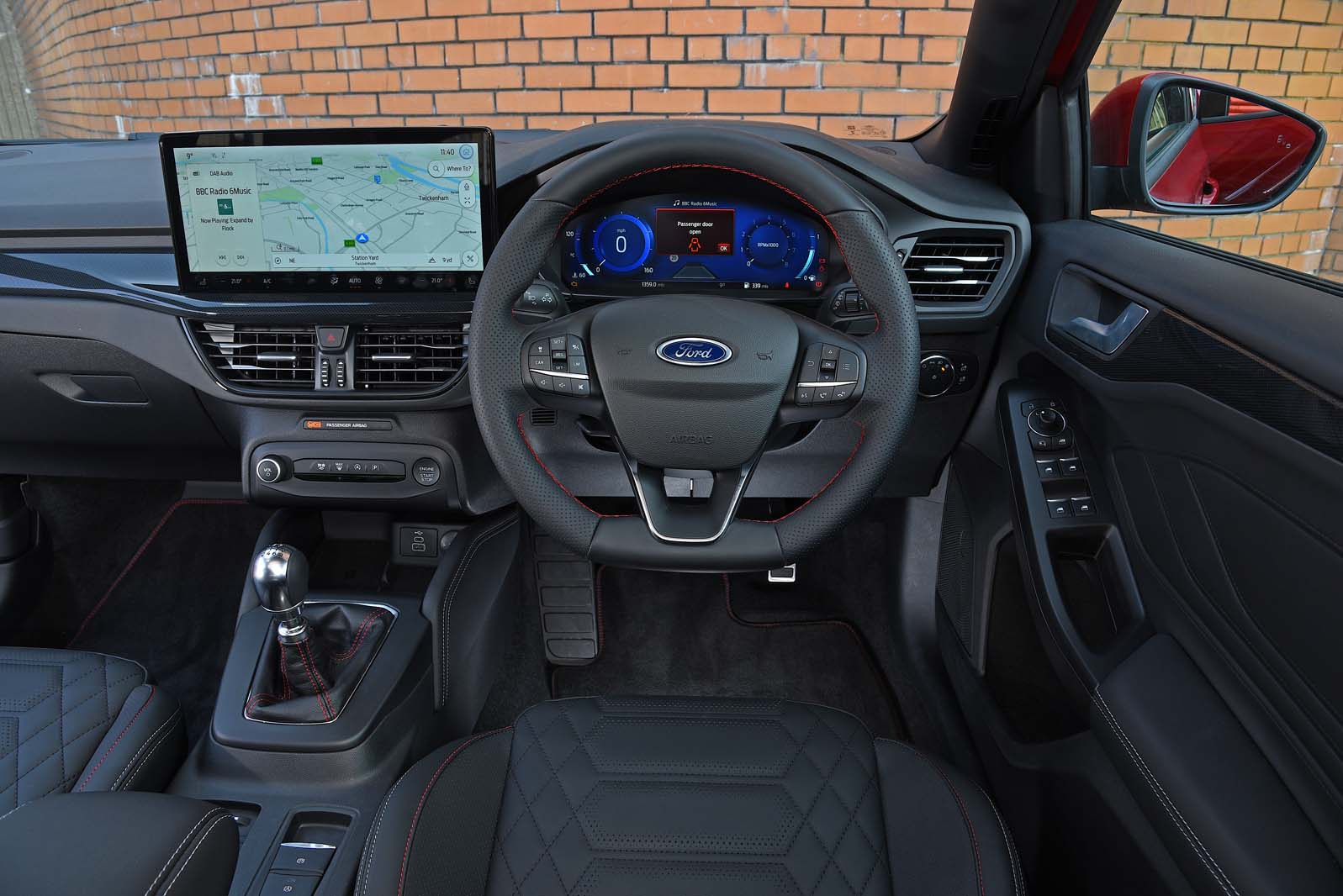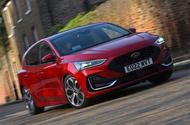Car pictured is in ST-Line trim
Affordable yet accomplished hatchback gets one last update before its 2025 demise
It’s remarkable how quickly things are changing in the car industry. When the fourth-generation Ford Focus came out in 2019, it seemed a significant event, yet not even three years later, the car feels like a bit of an anachronism – an impression only strengthened by confirmation that Cologne will in 2025 end production of what for decades has been the definitive affordable family hatchback.
In another sign of the times, the traditional mid-life facelift is, in this instance, far more focused on the digital than the mechanical side. Where the Focus used to have an 8.0in infotainment touchscreen stuck atop the centre of the dashboard and running Ford‘s Sync3 software, there’s now a 13.2in one running the latest evolution, surprisingly named Sync4.
The key feature of this is the introduction of over-the-air software updates, allowing your Focus to stay current long after it has left the showroom; plus cloud-connected features such as live traffic information for the sat-nav and Alexa-style voice control via natural speech.
As for the actual car stuff, the front end has gained a new-look bumper, grille and headlights and the 48V mild hybridisation of the Ecoboost 1.0-litre three-cylinder turbo petrol engine has gone from being niche to mainstream. Meanwhile, its 1.5-litre four-cylinder relation has been quietly deleted. That means petrol buyers can now choose a non-MHEV 99bhp unit or a 123bhp or 153bhp one without or with the MHEV, which costs an extra £1400. Of course, there also remains the 276bhp 2.3-litre four-cylinder Focus ST hot hatch.
The wider roll-out of Ford’s efficiency-boosting technology is partly thanks to it having been made compatible with a seven-speed dual-clutch automatic gearbox (DCT). Previously, MHEV buyers were restricted to a six-speed manual, while one-foot cars used an eight-speed torque-converter. Ford claims the new driveline pairing also makes the Focus more efficient and fun to drive.

More active safety technologies have also been introduced to the Focus, presumably at the behest of Euro NCAP: blindspot assistance, intersection assistance, adaptive cruise control with stop and go, traffic sign recognition and lane keeping assistance.
There’s very little to differentiate the driving experience of the Focus from what went before – which could hardly be further from criticism. It has that distinctly European Ford feeling of being a normal, affordable car that can sensibly, comfortably and practically transport the family around at the weekend, but always with cheeky, tacit hints that when you’re driving to work alone on Monday, it will enjoy letting loose just as much as you might.
Disappointingly, every petrol Focus bar the ST now comes with a twist-beam rear axle; the 1.5 Ecoboost used to come with a fully independent double-wishbone backside. However, it doesn’t make it feel rudimentary, like you might imagine. In fact, a senior Ford executive told us at the original launch that the only real difference between the set-ups was more noticeable impacts over potholes, and I can’t really argue with that.
On the modest 16in wheels and delightfully tall-sidewall tyres of second-rung Titanium trim, the ride remains comfortable in the primary sense, although the secondary sensations are still rather jittery over the poor surfaces that are all too common on British roads.
It never crashes alarmingly or becomes harsh, though – certainly not compared with something like a Mini Cooper. It means that after a while you get used to the way the Focus makes steady progress and the perception of those slightly rougher edges quickly fades into the back of your consciousness. Equally, it’s nothing like the supremely wafty new DS 4, being noticeably firmer than even the Skoda Octavia, although the payoff is of course sporty handling.
On the subject of which, the steering is surprisingly light. I recall it taking on a meatier feel in the sportier ST-Line version (which incidentally is pictured here with its side skirts, faux rear diffuser and chubbier steering wheel and red stitching) yet it still suits the character of the Focus here, being perfectly accurate and giving more feedback than we’re used to nowadays – meaning that there is some.
Dive into an inviting corner and the chassis responds without hesitation, thereafter keeping to your chosen line obediently, making B-road blats a real blast. Plus ça change – pour de bon. Unabated too is the slight over-sensitivity when you’re trying to effortlessly track straight on the motorway, but hey ho. Modern Ford’s hallmark elasticity in the steering motion also remains; you will either love this or find it too caricatured.
The general sense of engagement is heightened further by the presence of a third pedal and a stick protruding from the centre console. These amazing interlinked devices, the likes of which today feel very novel indeed, allow you to change between gear ratios yourself, either up or down, rather than simply crushing the accelerator pedal and letting a computer do that for you. It’s a wonder that this idea hasn’t caught on, even if it does make slow-moving traffic even more annoying to be stuck in…
Obviously the six-speeder in the Titanium isn’t as satisfying to use as that which Ford puts in the Focus ST, feeling less precise, but there’s still so much good to be said about it. Faster and slicker the new DCT may well be, but you’re never going to relish country roads like you do here, thanks to such tactility.
 In fact, tactility is the crux of my main – and very significant – criticism of the facelifted Focus. Previously, beneath the touchscreen existed a panel of dials and buttons for controlling the fan speed, temperature and direction of the air conditioning system. Alas, no more, here instead just a dial for the audio volume, four buttons for rarely used tech functions and the engine stop/start button.
In fact, tactility is the crux of my main – and very significant – criticism of the facelifted Focus. Previously, beneath the touchscreen existed a panel of dials and buttons for controlling the fan speed, temperature and direction of the air conditioning system. Alas, no more, here instead just a dial for the audio volume, four buttons for rarely used tech functions and the engine stop/start button.
Now to change anything related to the interior climate you have to concentrate on holding your arm aloft while it’s jiggled over the road surface and prod it at the screen. And despite this now being the size of a laptop screen, the appropriate icons are only a few centimetres across, while the menus are fiddly. What the hell, Ford? Why? How many more studies have to be conducted into the safety of touchscreens before manufacturers stop moving frequently used functions onto them, requiring the driver to look away from the road ahead? It’s exasperating.
As for the rest of the interior, I’ve never understood the popular criticism that the interior of the Focus looks dull and feels cheap. I always liked the layout, because everything important was in a sensible location, and enjoyed the hardly noticeable combination of analogue dials with a central information screen. Okay, so the materials were mostly black and grey, but is that really so bad? And yes, they didn’t feel like they came from an Audi, but neither does the Volkswagen Golf any more, and you can still buy the Focus for as little as £23,500.
The Focus, then, as before this facelift, is a really highly commendable family car, being inherently good-looking thanks to its hatchback proportions, rather than a blobby crossover; superbly set up for enjoyable handling without detriment to comfort; easily spacious enough for two adults up front and two children in the back; and surprisingly cheap.
The Mk4 latterly felt like the last bastion of sensible yet enjoyable and affordable ICE family cars for the middle class. The Mk4.5 remains all of those things, just with one unnecessary, infuriating flaw.
Source: Autocar
